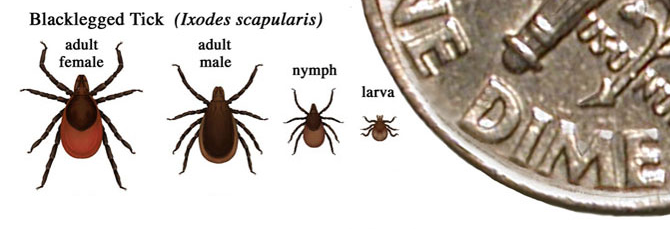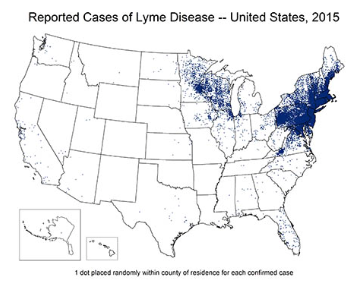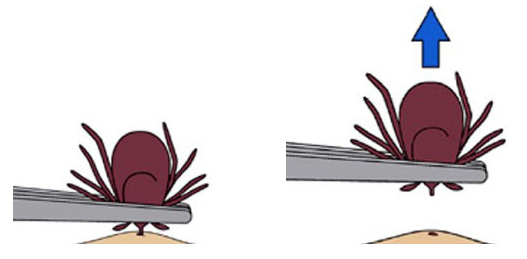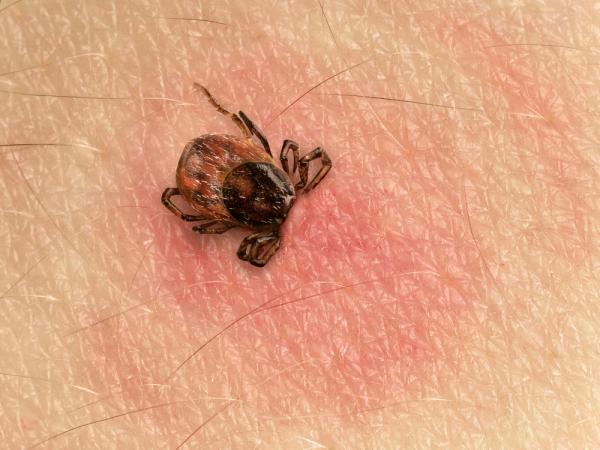When it comes to story ideas, sometimes plenty of research and contemplation is involved. But sometimes, they just appear out of nowhere. Other times still, it seems that they just reach up and bite you.
In this case, I mean literally.
Over the weekend, I went off my deck for a short stretch of time, venturing around the house's perimeter to take a good look around, given it's been awhile since I last did. It wasn't for long, and since it was still relatively chilly that day I didn't think much about tick risks.
However, a few hours later I was surprised when I looked down to discover a blacklegged bloodsucker on my lower leg behind my knee, having a nice meal at my expense.
Shortly after plucking and zip-lock bagging that unwelcome guest, it occurred to me that despite all I already knew about ticks and the threats they present, it certainly would serve me well to re-acquaint myself with these little buggers now that the next three outdoor seasons – spring, summer and fall – are here, or coming our way.
I decided to read up a bit, and here's what I found. And if you've been unaware of the latest tick trends and would like to learn something, then read on.
First of all, reports from around the country – mostly in the northern half of the U.S., where ticks thrive – reveal that 2017 is shaping up to be a pretty bad tick season. (Yes, ugh, was my first reaction, too.) The reasons have to do with the combination of a relatively mild winter, and an active and growing population among mice and deer.
And an abundance of acorns.
 Acorns? Yes, more than normally are around at this time of year.
Acorns? Yes, more than normally are around at this time of year.
Acorns attract mice. Mice survived and prospered nicely in the warmer winter temperatures. Mice carry Lyme disease.
Ticks, for their part, climb aboard mice for splendiferous meals and awesome rides through the woods and fields. That is, until they've had enough, leap on a human host, and the infected tick transmits the disease to you.
“Ticks survive really well when they feed on a mouse compared to other animal hosts so more ticks survive to the nymph stage,” said Dr. Richard Ostfeld, from the Cary Institute of Ecosystem Studies in Millbrook, N.Y., as reported April 24 by the Wall Street Journal. "So our expectation is that we should have an unusually large number of infected nymph-stage ticks starting next month.”
Which is now.
So before you head outside, here's a bullet-point refresher about ticks, their behavior, and strategies to steer clear of these (occasionally) disease-ridden pests:
TICK FACTS
- First of all, not all ticks deliver Lyme disease. Of the 10-to-30 percent that do, those carry the bacterium Borrelia burgdorferi.
- Not all regions of the U.S. have Lyme disease, since the country's southern portion and Rocky Mountain region are largely unaffected. It is found mostly in the "Northeast and mid-Atlantic, from northeastern Virginia to Maine; North central states, mostly in Wisconsin and Minnesota; West Coast, particularly northern California," according to the CDC.
 Two years ago, "95% of confirmed Lyme disease cases were reported from 14 states." They are, as the CDC's map shows:
Two years ago, "95% of confirmed Lyme disease cases were reported from 14 states." They are, as the CDC's map shows:
- Maine
- New Hampshire
- Vermont
- Massachusetts
- Rhode Island
- Connecticut (& Old Lyme, CT, first identified)
- New York
- New Jersey
- Pennsylvania
- Delaware
- Maryland
- Virginia
- Wisconsin
- Minnesota
- With a larger mice population, health officials in 2017 expect to see much more than the roughly 30,000 annual cases.
- Ticks feed on deer, too. But since deer don't carry Lyme disease they don't infect the tick. Therefore, aside from being a food source, ticks basically use deer for transportation.
- Once on a human, ticks typically need 1-to-2 days to transmit disease.
- If a tick – remember, not all of them, only ones that are disease carrying – is found within hours or half a day, it's unlikely to infect you (which is why inspection, after being outdoors, is crucial).
- Ticks live for approximately two years.
- Once a person is treated for Lyme's disease – usually with antibiotics – Lyme disease does not stay with you.
STAYING TICK-FREE
- When you're outside among nature, dress smartly: wear long sleeves; wear long pants with the ends tucked into your socks, which are pulled up on the outside; wear light colored clothing to help spot these dark-colored nuisances.
- If you can avoid it, stay out of wooded areas or ones with tall grass.
- On clothes and exposed skin, make sure to apply insect repellent that contains at least 25 percent DEET.
 Once back indoors, check for ticks. They tend to crawl to warm areas of the body, so look carefully all over. And ask someone to check areas you can't see, like the scalp, around the ears and groin.
Once back indoors, check for ticks. They tend to crawl to warm areas of the body, so look carefully all over. And ask someone to check areas you can't see, like the scalp, around the ears and groin.
And if you do find one of these guys/gals use a pair of tweezers to extract him/her. But reach for the very bottom of this critter – as the image shows (courtesy: CDC) – cause you don't want to dissect it, leaving a portion behind in your skin.




